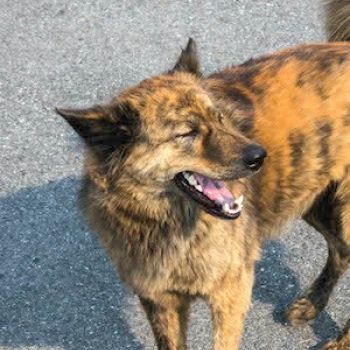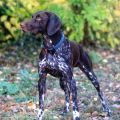The Kai dog, also known as the Kai Ken or Tora Inu, is a fascinating and rare breed that originates from Japan. With its striking appearance and loyal nature, the Kai dog has gained popularity among dog enthusiasts worldwide. This breed is known for its distinctive brindle coat, which sets it apart from other Japanese dog breeds.
The history of the Kai dog can be traced back to the mountainous region of Kai, located in Yamanashi Prefecture, Japan. These dogs were primarily used for hunting small game, such as boar and deer, in the dense forests of the area. Due to their exceptional hunting skills and adaptability to harsh weather conditions, the Kai dogs were highly valued by the local hunters.
According to the FCI (Fédération Cynologique Internationale) typology, the Kai dog belongs to Group 5, which includes the Spitz and Primitive type dogs. Within this group, the Kai dog is classified under Section 5, the Asian Spitz and related breeds. This classification highlights the breed's close relation to other Japanese Spitz breeds, such as the Shiba Inu and Akita Inu.
The Kai dog is primarily a working breed, known for its hunting abilities and loyalty to its owner. These dogs are highly intelligent and have a strong sense of independence, making them suitable for experienced dog owners who can provide them with proper training and socialization. They are known to be reserved with strangers but form strong bonds with their family members.
In terms of physical characteristics, the Kai dog is a medium-sized breed, with males typically weighing between 30-40 pounds (13-18 kg) and females slightly smaller at 25-35 pounds (11-16 kg). They have a well-muscled body, a broad head, and erect ears that give them a keen and alert expression. The most distinctive feature of the Kai dog is its brindle coat, which can come in various shades of brindle, ranging from light to dark.
The average height of a Kai dog is around 17-20 inches (43-51 cm) at the shoulder. They have a sturdy build and are known for their agility and endurance. With proper care and a balanced diet, the Kai dog has a life expectancy of around 12-15 years, allowing for many years of companionship and loyalty.
One interesting fact about the Kai dog is its ability to adapt to different environments. Despite being originally bred for mountainous regions, they can thrive in various climates, including both hot and cold weather. This adaptability makes them suitable for families living in different geographical locations.
In conclusion, the Kai dog is a remarkable breed with a rich history and unique characteristics. Their hunting skills, loyalty, and striking brindle coat make them stand out among other Japanese dog breeds. While they require experienced owners and proper training, the Kai dog can be a wonderful companion for those who appreciate their intelligence and independent nature.

The Kai dog, also known as the Tora Inu or the Tiger Dog, is a fascinating breed with a unique character that sets them apart from other dogs. Originating from Japan, these medium-sized canines possess a distinct set of traits that make them a wonderful addition to any family. In this text, we will delve into the character of Kai dogs, exploring their behavior, how to raise them, and the best training methods for this breed.
Kai dogs are known for their loyal and affectionate nature. They form strong bonds with their owners and are incredibly devoted to their families. This breed thrives on human companionship and loves being involved in family activities. Whether it's going for a hike, playing in the yard, or simply cuddling on the couch, Kai dogs are happiest when they are by their owner's side.
Despite their loyalty, Kai dogs can be reserved and cautious around strangers. They have a natural instinct to protect their loved ones, making them excellent watchdogs. However, early socialization is crucial to ensure they are comfortable around new people and situations. Introducing them to various environments, people, and animals from a young age will help them develop into well-rounded and confident dogs.
Kai dogs are intelligent and eager to please, making them relatively easy to train. They respond well to positive reinforcement techniques, such as treats, praise, and play. Consistency and patience are key when training a Kai dog, as they can be independent and stubborn at times. It is important to establish clear boundaries and provide them with mental stimulation to prevent boredom, which can lead to destructive behaviors.
Exercise is an essential part of raising a Kai dog. They have a moderate energy level and require daily physical activity to keep them mentally and physically stimulated. Long walks, runs, or play sessions in a securely fenced yard are ideal for this breed. Engaging them in interactive games or providing puzzle toys will also help satisfy their intelligent and curious nature.
Kai dogs have a strong prey drive, which means they may chase small animals. It is crucial to keep them on a leash or in a securely fenced area to prevent any accidents. Early socialization with other animals, including cats and other dogs, can help reduce any potential aggression or chasing behavior.
Grooming a Kai dog is relatively low maintenance. They have a thick double coat that sheds moderately throughout the year, with heavier shedding during seasonal changes. Regular brushing will help keep their coat healthy and reduce shedding. Bathing should be done as needed, typically every few months, to maintain their cleanliness.
In conclusion, Kai dogs are loyal, affectionate, and protective companions. They require early socialization, consistent training, and plenty of exercise to thrive. With the right approach, this breed can become a well-behaved and loving member of any family. If you are looking for a devoted and intelligent dog that will bring joy and companionship to your life, the Kai dog may be the perfect choice for you.
The Kai dog, also known as the Tora Inu or Tiger Dog, is a rare and ancient Japanese breed known for its loyalty, intelligence, and agility. Caring for a Kai dog requires a deep understanding of their unique needs and characteristics. Here are some essential tips on how to care for dogs of this breed, including what to do and what not to do:
1. Provide regular exercise: Kai dogs are highly energetic and require daily exercise to maintain their physical and mental well-being. Engage them in activities like long walks, jogging, or playing fetch. A tired Kai dog is a happy and well-behaved one.
2. Mental stimulation is crucial: These intelligent dogs thrive on mental challenges. Incorporate puzzle toys, obedience training, and interactive games into their routine. This will prevent boredom and destructive behavior.
3. Establish a consistent routine: Kai dogs appreciate a structured environment. Set a fixed schedule for feeding, exercise, and training. Consistency helps them feel secure and reduces anxiety.
4. Socialize from an early age: Early socialization is vital for Kai dogs to develop good manners and become well-rounded companions. Introduce them to various people, animals, and environments to build their confidence and prevent aggression or fearfulness.
5. Positive reinforcement training: Kai dogs respond best to positive reinforcement techniques such as treats, praise, and play. Harsh training methods or punishment can damage their trust and cause behavioral issues.
6. Grooming needs: Kai dogs have a double coat that sheds moderately year-round and heavily during shedding seasons. Regular brushing will help control shedding and keep their coat healthy. Bathing should be done as needed, using a dog-specific shampoo to maintain their natural oils.
7. Dental care: Like all dogs, Kai dogs require regular dental care. Brush their teeth at least two to three times a week using a dog-friendly toothpaste and toothbrush. Regular dental check-ups are also recommended.
8. Provide a balanced diet: Feed your Kai dog a high-quality, balanced diet that suits their age, size, and activity level. Consult with a veterinarian to determine the appropriate portion sizes and nutritional requirements.
9. Health check-ups: Regular veterinary check-ups are essential to monitor your Kai dog's overall health. Vaccinations, parasite prevention, and annual blood work are crucial to ensure their well-being.
10. Avoid overexertion: While Kai dogs are known for their endurance, avoid excessive exercise, especially during hot weather. They are prone to heatstroke, so provide plenty of water and shade during outdoor activities.
11. Avoid isolation: Kai dogs are deeply loyal and thrive on human companionship. Avoid leaving them alone for extended periods as it can lead to separation anxiety and destructive behavior. Consider doggy daycare or a trusted pet sitter if you're away for long hours.
12. Be cautious with small animals: Kai dogs have a strong prey drive, so be cautious when introducing them to small animals like cats, rabbits, or rodents. Early socialization and training can help minimize this instinct, but supervision is always recommended.
Remember, every Kai dog is unique, and individual care requirements may vary. Understanding their breed traits and providing a loving, stimulating, and consistent environment will ensure a happy and healthy life for your Kai dog.
The Kai dog, also known as the Tora Inu or Tiger Dog, is a beautiful and distinctive breed that hails from Japan. When it comes to their coloration, Kai dogs are predominantly known for their striking brindle coats. Brindle refers to a pattern of dark stripes or streaks that are overlaid on a lighter base color, creating a unique and eye-catching appearance.
The base color of Kai dogs can vary, but it is most commonly a warm, reddish-brown shade. This rich hue resembles the color of autumn leaves, with hints of mahogany and chestnut. The intensity of the base color can range from a lighter, golden brown to a deeper, almost chocolatey tone. This warm base color serves as the canvas upon which the brindle pattern is displayed.
The brindle pattern on a Kai dog's coat is what truly sets them apart. The dark stripes or streaks that overlay the base color can vary in thickness, length, and density, creating a mesmerizing tapestry of colors. These stripes can be black, dark brown, or even a deep charcoal gray, contrasting beautifully against the warm base color. The brindle pattern can appear in various forms, such as tiger stripes, irregular patches, or even a marble-like effect, giving each Kai dog a unique and individual look.
The brindle pattern on a Kai dog's coat is not only visually appealing but also serves a practical purpose. Historically, these dogs were used for hunting in the mountainous regions of Japan, where their brindle coats helped them blend seamlessly with their natural surroundings. The stripes and streaks mimic the dappled light and shadows found in dense forests, allowing them to remain camouflaged while on the hunt.
In addition to their brindle coats, Kai dogs may also have white markings on their chest, paws, and tail tip. These white patches provide a delightful contrast to the warm base color and the dark brindle pattern, adding an extra touch of elegance to their appearance.
It is worth noting that while brindle is the most common color for Kai dogs, there are also variations within the breed. Some Kai dogs may have solid coats in shades of black, red, or sesame, which is a mix of black and red hairs. However, these solid-colored Kai dogs are less common and tend to be overshadowed by their brindle counterparts.
In conclusion, the common color of Kai dogs is a warm, reddish-brown base coat with a striking brindle pattern of dark stripes or streaks. This unique coloration, combined with their white markings, gives Kai dogs a distinctive and captivating appearance that truly sets them apart from other breeds.
The Kai dog, also known as the Tora Inu or the Tiger Dog, is a medium-sized breed that originated in Japan. These dogs are known for their intelligence, loyalty, and strong hunting instincts. When it comes to their health, Kai dogs are generally considered to be a robust and healthy breed. However, like any other dog breed, they are prone to certain health issues that owners should be aware of.
One of the most common health concerns in Kai dogs is hip dysplasia. This is a genetic condition where the hip joint doesn't develop properly, leading to pain, lameness, and arthritis. Regular exercise and maintaining a healthy weight can help reduce the risk of hip dysplasia. Additionally, responsible breeders should perform hip evaluations on their breeding dogs to minimize the chances of passing on this condition.
Another health issue that can affect Kai dogs is patellar luxation. This occurs when the kneecap slips out of its normal position, causing discomfort and difficulty in walking. Regular veterinary check-ups can help detect this condition early on, and surgical intervention may be required in severe cases.
Kai dogs are also prone to allergies, which can manifest as skin irritations, itching, and gastrointestinal issues. Identifying and avoiding potential allergens, such as certain foods or environmental triggers, can help manage these allergies. Regular grooming and keeping the dog's coat clean can also minimize skin-related problems.
Like many other breeds, Kai dogs can also suffer from dental issues such as periodontal disease and tooth decay. Regular dental care, including brushing their teeth and providing appropriate chew toys, can help maintain good oral health.
To ensure the overall health and well-being of Kai dogs, it is important to provide them with a balanced diet that meets their nutritional needs. High-quality dog food, preferably formulated for medium-sized breeds, should be the foundation of their diet. Regular exercise is also crucial to keep them physically fit and mentally stimulated. Daily walks, playtime, and interactive toys can help fulfill their exercise requirements.
Regular veterinary check-ups are essential for monitoring the health of Kai dogs. Vaccinations, parasite prevention, and routine blood tests should be part of their healthcare regimen. Early detection of any potential health issues can lead to prompt treatment and better outcomes.
In conclusion, Kai dogs are generally a healthy breed, but they are susceptible to certain health conditions like hip dysplasia, patellar luxation, allergies, and dental problems. Responsible breeding practices, regular veterinary care, a balanced diet, and proper exercise can help maintain the health and longevity of these wonderful dogs. By providing them with the care they need, Kai dog owners can ensure their furry companions live happy and healthy lives.
The Kai dog, also known as the Tora Inu, is a medium-sized breed native to Japan. These dogs are known for their agility, intelligence, and loyalty. To ensure their overall health and well-being, it is crucial to provide them with a balanced and nutritious diet. Here is an extensive description of the nutrition requirements for Kai dogs, along with advice on feeding and what to avoid.
Protein is an essential component of a Kai dog's diet. It aids in muscle development, repair, and overall growth. High-quality sources of protein include lean meats like chicken, turkey, and fish. These should be cooked thoroughly to eliminate any harmful bacteria. Additionally, eggs and dairy products like yogurt can be included in moderation.
Carbohydrates are another vital part of a Kai dog's diet as they provide energy. Opt for complex carbohydrates such as brown rice, sweet potatoes, and whole grains. These are rich in fiber, which aids in digestion and helps maintain a healthy weight. Avoid feeding your Kai dog excessive amounts of simple carbohydrates like white bread or sugary treats, as these can lead to weight gain and other health issues.
Fats are an essential nutrient for Kai dogs, but it is important to choose healthy sources. Incorporate omega-3 fatty acids into their diet, which can be found in fish oil or flaxseed oil. These fats promote a healthy coat, reduce inflammation, and support brain function. However, be cautious not to overfeed fats, as excessive consumption can lead to obesity.
Fruits and vegetables are excellent additions to a Kai dog's diet. They provide essential vitamins, minerals, and antioxidants. Some safe options include carrots, green beans, blueberries, and apples. However, avoid feeding your dog grapes, raisins, onions, garlic, or avocados, as these can be toxic to dogs.
It is crucial to provide fresh, clean water to your Kai dog at all times. Hydration is essential for proper digestion, organ function, and overall health. Ensure that the water bowl is always filled and clean.
Feeding schedules may vary depending on your dog's age, activity level, and overall health. Puppies require more frequent meals, typically three to four times a day, while adult Kai dogs can be fed twice a day. Avoid free-feeding or leaving food out all day, as it can lead to overeating and weight gain.
Portion control is essential to prevent obesity in Kai dogs. Measure the appropriate amount of food based on your dog's weight, age, and activity level. Consult with your veterinarian to determine the right portion size for your specific dog.
Avoid feeding your Kai dog table scraps or human food, as this can lead to digestive issues, nutrient imbalances, and obesity. Some human foods, such as chocolate, caffeine, alcohol, and certain spices, are toxic to dogs and should be strictly avoided.
Regular exercise is crucial for Kai dogs to maintain a healthy weight and overall well-being. Combine a balanced diet with daily physical activity to ensure your dog's optimal health.
In conclusion, a nutritious diet is vital for the well-being of Kai dogs. Provide them with high-quality protein, complex carbohydrates, healthy fats, and a variety of fruits and vegetables. Avoid toxic foods, overfeeding, and excessive fats. Always consult with your veterinarian for personalized advice on your Kai dog's specific dietary needs.





